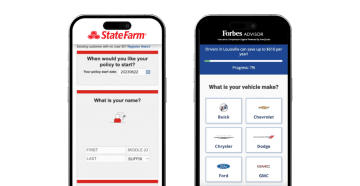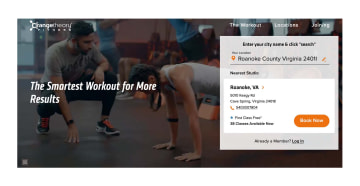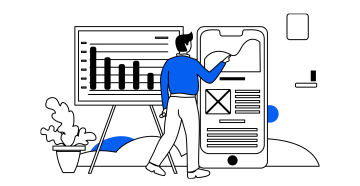Guides & best practices
View all articlesA guide to form builders and how to unlock their lead generation potential

It’s Saturday night. You’re going out and meeting someone in a bar. You have a great conversation with them from beginning to end. There’s a connection, there’s a spark, there’s magic. But then, when you’re about to leave, the person just hands you a piece of paper and yells at you: “Phone number!” instead of asking you nicely with a smile. And just like that, this ending ruined the whole experience for you.
It’s the same with websites. What use are the fancy design, the on-point copy or the special effects, if the form you use to capture the visitor’s information is an ugly, static form from the last century? But here is the good news: you can avoid this by using a form builder.
In this guide we will clarify what form builders are, explore their benefits, how you can leverage them to improve your lead generation, and take a look at what factors to consider when selecting a form builder that fits your needs.
What is a form builder?
A form builder is a tool that helps you create online forms for your website, emails, apps, or other places. In the past, it required some coding to create such online forms, so marketers and companies were dependent on developers for that, but nowadays thanks to no-code form builders anyone can create an online form easily. The more user-friendly form builder platforms offer an intuitive interface in which forms can be created easily through drag-and-drop.
Different types of form builders
There are many different form builders in the market. From free tools to paid ones, from more simple ones to more advanced ones, there’s something there for every taste and preference. The more simple ones offer the basic functions you need to create a standard form asking regular questions to collect answers from your users.
The more advanced form builders allow you to create interactive forms with a higher level of personalization. These form builders offer more advanced features, integrations with a variety of CRMs and other tools, and more customization options. Depending on your goals and what you’re looking for, you can definitely find one that suits your needs. One question you should ask yourself beforehand is, whether you will need to create single-step forms or interactive multi-step forms, since this will also inform your choice of form builder.

Main benefits of form builders
Let’s take a closer look at the benefits that form builders can offer.
Efficiency & scalability. Using a form builder, collecting information from your website visitors and potential customers can happen faster and with less effort. Once you create an online form, you can duplicate it easily for your next use case, adjust it, and it’s ready to go.
Enhanced user experience. Thanks to the modern form builders that exist today, the experience of filling out a form doesn’t have to be tedious, boring or intimidating anymore. Especially when using a builder for interactive forms (also known as multi-step forms), you can offer your audience a truly engaging and personalized experience, in which the form dynamically reacts to their input. If the user indicates they don’t own a car, just make them skip all the car insurance related questions. The user told you their first name at the start of the form? Pick it up and use it for the rest of the form to address them by their name!
Increased leads / submissions. As a result of the above, interactive forms created with modern form builders tend to get more submissions, i.e. leads. When a user sees a form they can navigate through one question at a time, and on top of it experiences a much higher level of personalization than with standard static forms, they won’t mind submitting their information. They will likely even enjoy it, because it feels more like a conversation or a game than a tedious data collection process.
Better segmentation / qualification of leads. Using a form builder, it’s much easier to pre-qualify and segment your leads. Group them based on their responses to certain questions, and send them into different email drips or marketing workflows. Most form builders have integrations with all relevant CRMs and marketing/sales tools. A lot of the tasks you used to do manually can now be automated with the help of form builders.
How form builders can boost your lead generation
There are various ways in which form builders can help you enhance your lead generation. Make sure you make use of all the powerful features they have to offer to realize its full potential, for example in the following ways.
Make it visually appealing and let your creativity roam free. Modern form builders offer you a multitude of design options to style your form to create a wow-effect, so make use of it. Use colors, adapt fonts, embed photos and videos if appropriate, or insert icons for your answer options instead of plain text. A form with a slick design will make it much more likely your audience sticks around till the end and completes it.

Make it a seamless experience. Embed your form on your website instead of creating it as a standalone page. Giving your users the possibility to stay on the page where they are instead of clicking a link that leads them somewhere else to fill out your form reduces friction significantly and makes the process more seamless. The less steps required, the more likely they are to complete your form and submit their information.

Speed up the follow-up and response time. By automating parts of the process, you can reduce the time of the follow-up steps after the form submission. For instance, you can set up automated, personalized emails to the users as a response to their form submission. A good form builder will also offer you the option to customize and personalize these response emails, so that you can send your users more than just a generic “Thank you for submitting your information”.
Moreover, make use of the integrations the form builder offers to connect your form to your marketing and sales stack, and automate e.g. the lead scoring process, audience segmentation, or the customization of lead nurture flows.
A/B-test different versions of your form. If you’re a lead gen and CRO pro, you know about the importance of A/B testing. Sometimes the tiniest change on a page can generate a significant conversion uplift. Same goes for online forms. Changing the order of questions, visuals or colors can make it more likely that your audience will complete your form. Some form builders have a built-in A/B testing feature which allows you to run A/B test inside the platform, without the need of integrating your form builder with external tool. (If you need some inspo on what elements to A/B-test in your forms, here are 7 ideas from us.)

Factors to consider when picking a form builder
We’ve already looked at the different functions a form builder can fulfill. You might not need all of them, though. How you select the right form builder depends heavily on what you’ll need it for, your use cases, the stage your business is in, your objectives, and more. Here are some of the main factors you should take into account when selecting a form builder.
Simple vs. advanced
Think about what kind of forms you will want to build. Will it be simple, straightforward short forms just to collect a few pieces of information? Then a free form builder version with basic features will do just fine. However, if you care about things like customizability to adapt the form to your needs and personalize it for your users, as well as the ability to automate processes around your lead generation, then a more advanced form builder with more feature power and integrations would make more sense.
Response volume
Who is your target audience? Where will they find your forms and how many of them are you expecting to visit it? Depending on the expected volume, you should choose a plan that suits that traffic, as many form builder platforms have their pricing plan structured based on the amount of responses you want to collect. Therefore, being clear about this question in advance will help you identify the plan you need, and discard form builders that don’t offer a suitable plan.
Design flexibility
How important is it to you being able to create forms that are visually appealing? Or that the form fits into your visual identity and represents your brand perfectly? Maybe you’re an agency with a broad customer portfolio and need to adapt everything you create, including online forms, to your clients’ brands? Make sure the form builder you choose offers the adequate level of design options and customizability.
Integrations
When you do your product research, check with what platforms the different form builders have integrations with. Make sure the form builder you select has integrations with a lot of your existing marketing and sales stack so you can set up automated processes around your lead generation as described above.
A/B testing
As mentioned above, through A/B testing you can find out what changes in your online form can generate an uplift in conversions. If you really want to leave no stone unturned and realize the entire potential of your online forms, we recommend experimenting with different variants to identify the best performing version. For that, a form builder with an integrated A/B testing function will definitely be a good investment.
Closing thoughts
Online forms turning website visitors off don’t have to be an obstacle to your lead generation anymore. A good form builder should be part of your martech, because creating interactive, engaging forms can not only help you boost your lead generation and conversion rates, but also influence the perception of your brand towards a tech-savvy, forward-thinking business. Invest in a form builder that has the features you need and create the kind of form experience that you would like to go through yourself as a user.
If you’re looking to create an outstanding user experience that converts more of your visitors into leads, try Heyflow. Heyflow lets you create interactive flows – the next evolution step of online forms – easily through drag-and-drop, without any coding required. Customize anything from colors to padding to achieve exactly the design you have in mind, and even add your custom code. Integrate your flows with your favorite CRM, marketing platforms and other tools. Analyze drop-off rates in the analytics tab and set up A/B tests to try different flow versions against each other – all conveniently within Heyflow.
If you want to try out Heyflow for free, sign up for your 14-day trial now.



